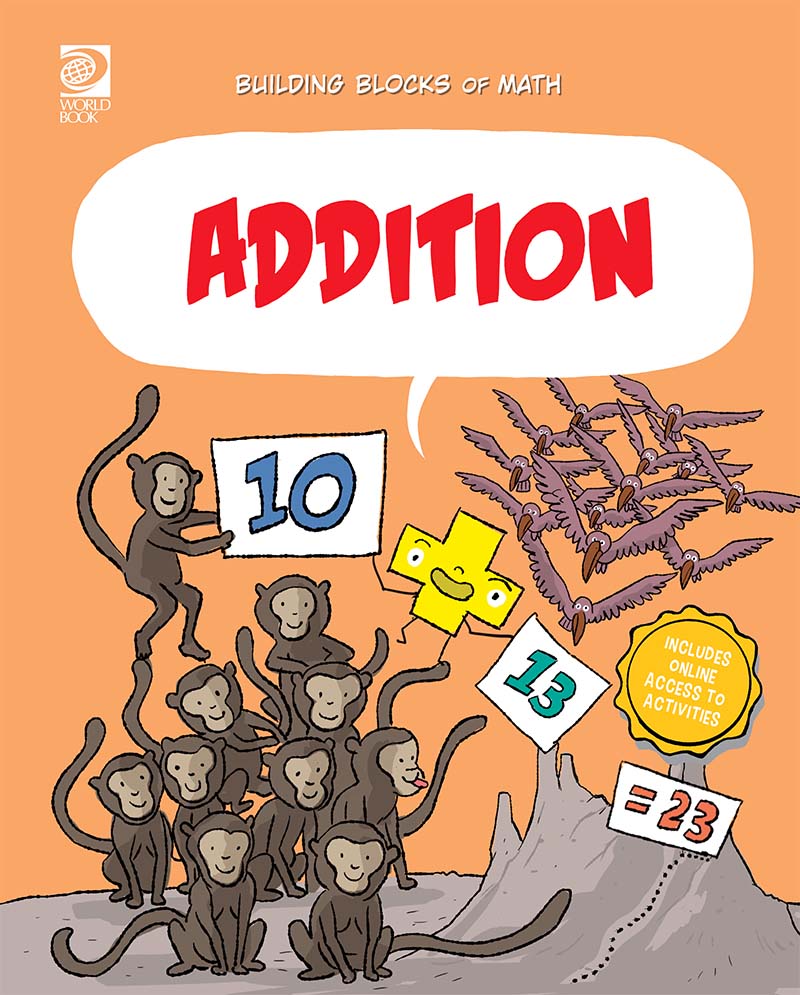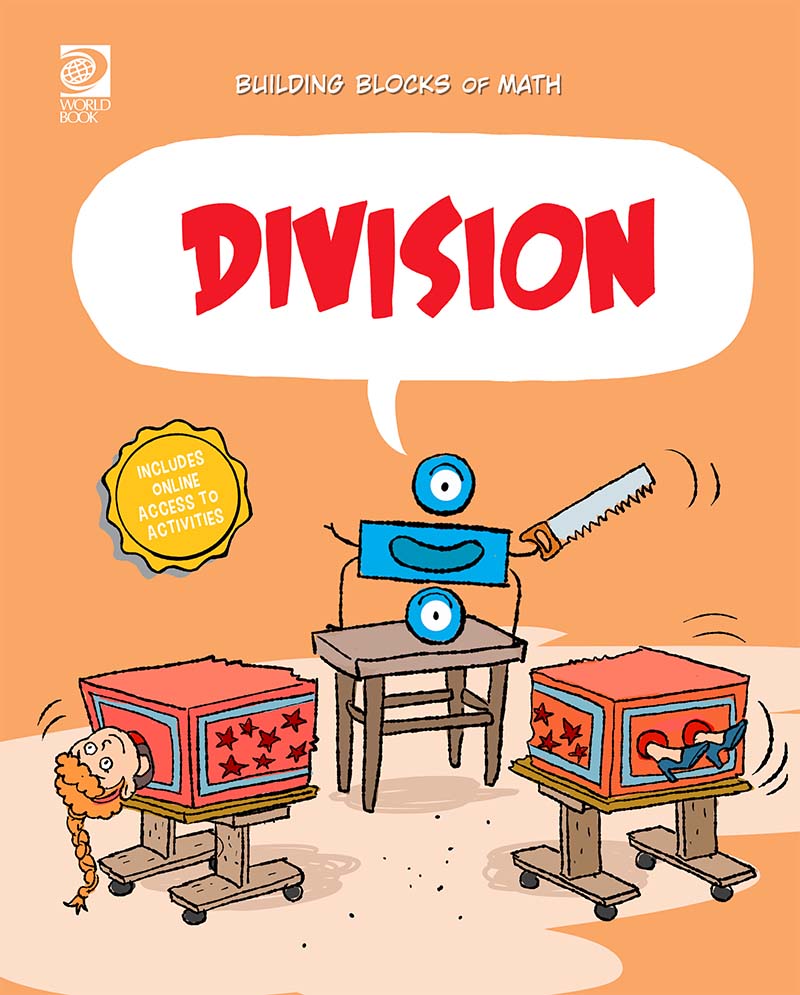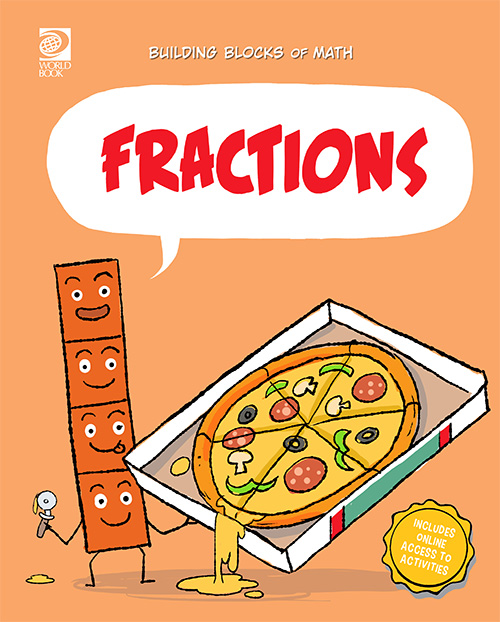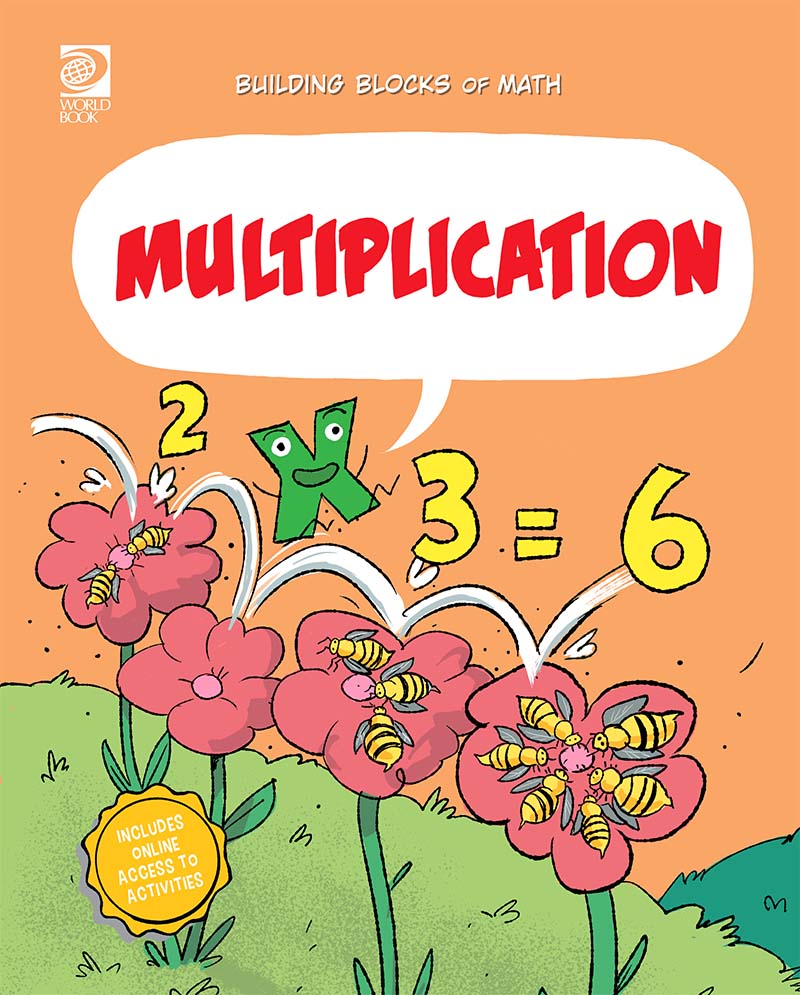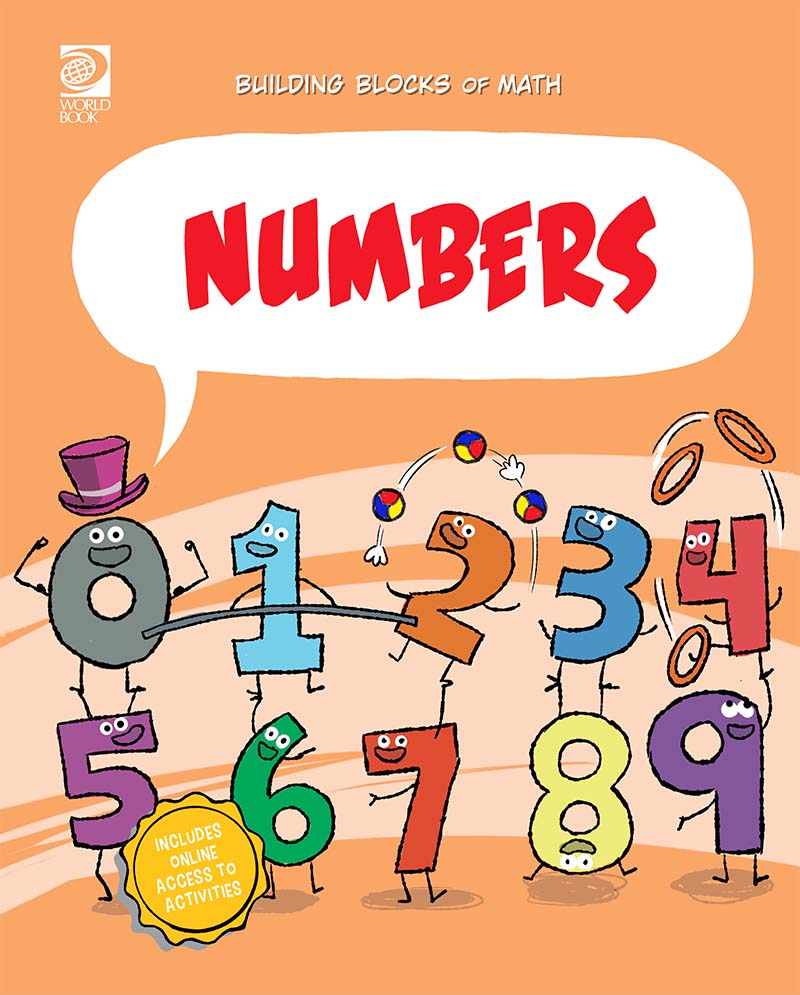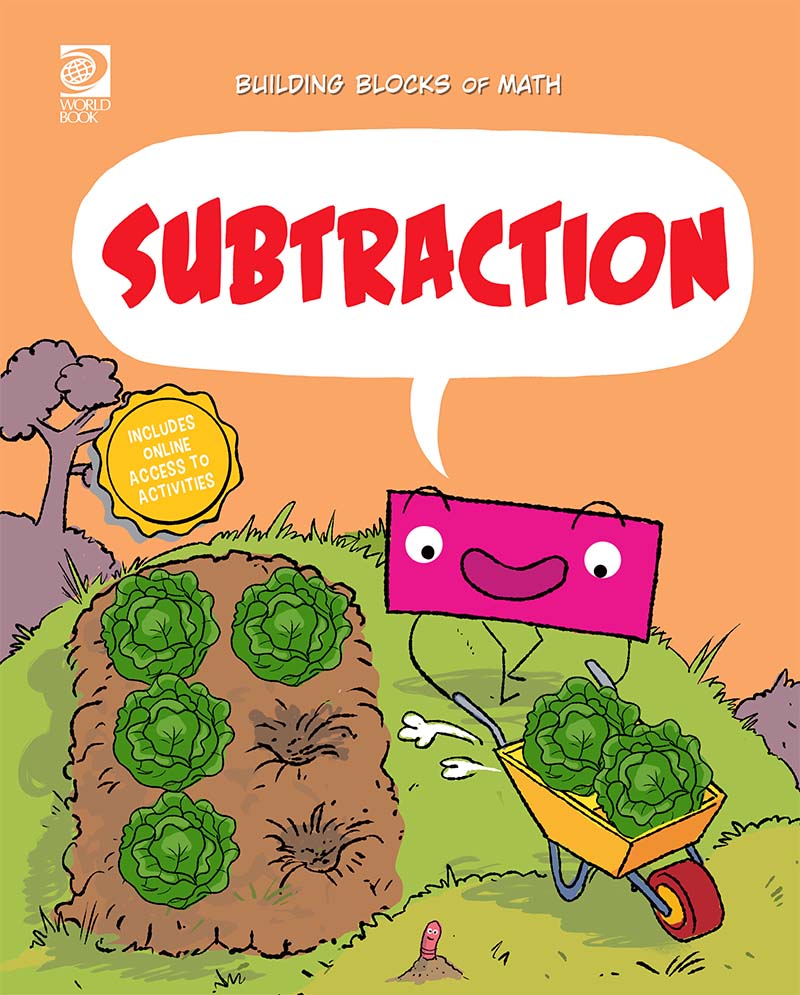Building Blocks of Math: Foundations
The Building Blocks of Math Educator Section includes tools as well as ready-to-use classroom materials. Educators can see how the Common Core State Mathematics Standards and the Common Core State Standards for Mathematical Practice align with the Building Blocks of Math books, organized by the grade level(s) they teach. In addition, educators will have access to reading resources such as discussion guides and comprehension checks. Because this series supports a conceptual understanding of mathematics, the classroom activities focus on a variety of strategies. These activities can be used to support students’ number sense understanding, flexibility with numbers, and overall confidence with math. Finally, the Educators Section also includes engaging lessons, centered around standards, with built-in differentiation options to support all learners as they continue to explore this content.
Building Blocks of Math Standards Alignment:
Use this section to view how the Common Core State Standards align to the Building Blocks of Math series.
-
Common Core State Standards for Mathematical Practice Students who demonstrate understanding can:
Mathematical Practice Standard Mathematical Practice Details Building Blocks Book(s) MP1 Make sense of problems and persevere in solving them. Mathematically proficient students start by explaining to themselves the meaning of a problem and looking for entry points to its solution. They analyze givens, constraints, relationships, and goals. They make conjectures about the form and meaning of the solution and plan a solution pathway rather than simply jumping into a solution attempt. They consider analogous problems, and try special cases and simpler forms of the original problem in order to gain insight into its solution. They monitor and evaluate their progress and change course if necessary. Older students might, depending on the context of the problem, transform algebraic expressions or change the viewing window on their graphing calculator to get the information they need. Mathematically proficient students can explain correspondences between equations, verbal descriptions, tables, and graphs or draw diagrams of important features and relationships, graph data, and search for regularity or trends. Younger students might rely on using concrete objects or pictures to help conceptualize and solve a problem. Mathematically proficient students check their answers to problems using a different method, and they continually ask themselves, "Does this make sense?" They can understand the approaches of others to solving complex problems and identify correspondences between different approaches. Addition, Subtraction, Multiplication, Division, Fractions MP2 Reason abstractly and quantitatively. Mathematically proficient students make sense of quantities and their relationships in problem situations. They bring two complementary abilities to bear on problems involving quantitative relationships: the ability to decontextualize—to abstract a given situation and represent it symbolically and manipulate the representing symbols as if they have a life of their own, without necessarily attending to their referents—and the ability to contextualize, to pause as needed during the manipulation process in order to probe into the referents for the symbols involved. Quantitative reasoning entails habits of creating a coherent representation of the problem at hand; considering the units involved; attending to the meaning of quantities, not just how to compute them; and knowing and flexibly using different properties of operations and objects. Addition, Subtraction, Multiplication, Division, Fractions MP4 Model with mathematics. Mathematically proficient students can apply the mathematics they know to solve problems arising in everyday life, society, and the workplace. In early grades, this might be as simple as writing an addition equation to describe a situation. In middle grades, a student might apply proportional reasoning to plan a school event or analyze a problem in the community. By high school, a student might use geometry to solve a design problem or use a function to describe how one quantity of interest depends on another. Mathematically proficient students who can apply what they know are comfortable making assumptions and approximations to simplify a complicated situation, realizing that these may need revision later. They are able to identify important quantities in a practical situation and map their relationships using such tools as diagrams, two-way tables, graphs, flowcharts and formulas. They can analyze those relationships mathematically to draw conclusions. They routinely interpret their mathematical results in the context of the situation and reflect on whether the results make sense, possibly improving the model if it has not served its purpose. Numbers, Fractions MP5 Use appropriate tools strategically. Mathematically proficient students consider the available tools when solving a mathematical problem. These tools might include pencil and paper, concrete models, a ruler, a protractor, a calculator, a spreadsheet, a computer algebra system, a statistical package, or dynamic geometry software. Proficient students are sufficiently familiar with tools appropriate for their grade or course to make sound decisions about when each of these tools might be helpful, recognizing both the insight to be gained and their limitations. For example, mathematically proficient high school students analyze graphs of functions and solutions generated using a graphing calculator. They detect possible errors by strategically using estimation and other mathematical knowledge. When making mathematical models, they know that technology can enable them to visualize the results of varying assumptions, explore consequences, and compare predictions with data. Mathematically proficient students at various grade levels are able to identify relevant external mathematical resources, such as digital content located on a website, and use them to pose or solve problems. They are able to use technological tools to explore and deepen their understanding of concepts. Numbers, Subtraction, Division, Fractions MP6 Attend to precision. Mathematically proficient students try to communicate precisely to others. They try to use clear definitions in discussion with others and in their own reasoning. They state the meaning of the symbols they choose, including using the equal sign consistently and appropriately. They are careful about specifying units of measure, and labeling axes to clarify the correspondence with quantities in a problem. They calculate accurately and efficiently, express numerical answers with a degree of precision appropriate for the problem context. In the elementary grades, students give carefully formulated explanations to each other. By the time they reach high school they have learned to examine claims and make explicit use of definitions. Addition, Subtraction, Multiplication, Division, Fractions MP7 Look for and make use of structure. Mathematically proficient students look closely to discern a pattern or structure. Young students, for example, might notice that three and seven more is the same amount as seven and three more, or they may sort a collection of shapes according to how many sides the shapes have. Later, students will see 7 × 8 equals the well remembered 7 × 5 + 7 × 3, in preparation for learning about the distributive property. In the expression x2 + 9x + 14, older students can see the 14 as 2 × 7 and the 9 as 2 + 7. They recognize the significance of an existing line in a geometric figure and can use the strategy of drawing an auxiliary line for solving problems. They also can step back for an overview and shift perspective. They can see complicated things, such as some algebraic expressions, as single objects or as being composed of several objects. For example, they can see 5 - 3(x - y)2 as 5 minus a positive number times a square and use that to realize that its value cannot be more than 5 for any real numbers x and y. Numbers, Addition, Subtraction, Multiplication, Division, Fractions MP8 Look for and express regularity in repeated reasoning. Mathematically proficient students notice if calculations are repeated, and look both for general methods and for shortcuts. Upper elementary students might notice when dividing 25 by 11 that they are repeating the same calculations over and over again, and conclude they have a repeating decimal. By paying attention to the calculation of slope as they repeatedly check whether points are on the line through (1, 2) with slope 3, middle school students might abstract the equation (y - 2)/(x - 1) = 3. Noticing the regularity in the way terms cancel when expanding (x - 1)(x + 1), (x - 1)(x2 + x + 1), and (x - 1)(x3 + x2 + x + 1) might lead them to the general formula for the sum of a geometric series. As they work to solve a problem, mathematically proficient students maintain oversight of the process, while attending to the details. They continually evaluate the reasonableness of their intermediate results. Numbers, Addition, Subtraction, Multiplication, Division, Fractions -
1st Grade Common Core State Mathematics Standards Students who demonstrate understanding can:
Domain and Disciplinary Core Idea Standard Building Blocks Book(s) 1.OA.A Represent and solve problems involving addition and subtraction. Use addition and subtraction within 20 to solve word problems involving situations of adding to, taking from, putting together, taking apart, and comparing, with unknowns in all positions, e.g., by using objects, drawings, and equations with a symbol for the unknown number to represent the problem.1 Addition, Subtraction 1.OA.A.2 Solve word problems that call for addition of three whole numbers whose sum is less than or equal to 20, e.g., by using objects, drawings, and equations with a symbol for the unknown number to represent the problem. Addition 1.OA.B Understand and apply properties of operations and the relationship between addition and subtraction. 1.OA.B.3 Apply properties of operations as strategies to add and subtract.2 Examples: If 8 + 3 = 11 is known, then 3 + 8 = 11 is also known. (Commutative property of addition.) To add 2 + 6 + 4, the second two numbers can be added to make a ten, so 2 + 6 + 4 = 2 + 10 = 12. (Associative property of addition.) Addition, Subtraction 1.OA.B.4 Understand subtraction as an unknown-addend problem. For example, subtract 10 - 8 by finding the number that makes 10 when added to 8. Addition, Subtraction 1.OA.C Add and subtract within 20. 1.OA.C.5 Relate counting to addition and subtraction (e.g., by counting on 2 to add 2). Addition, Subtraction 1.OA.C.6 Add and subtract within 20, demonstrating fluency for addition and subtraction within 10. Use strategies such as counting on; making ten (e.g., 8 + 6 = 8 + 2 + 4 = 10 + 4 = 14); decomposing a number leading to a ten (e.g., 13 - 4 = 13 - 3 - 1 = 10 - 1 = 9); using the relationship between addition and subtraction (e.g., knowing that 8 + 4 = 12, one knows 12 - 8 = 4); and creating equivalent but easier or known sums (e.g., adding 6 + 7 by creating the known equivalent 6 + 6 + 1 = 12 + 1 = 13). 1.OA.D Work with addition and subtraction equations. 1.OA.D.7Understand the meaning of the equal sign, and determine if equations involving addition and subtraction are true or false. For example, which of the following equations are true and which are false? 6 = 6, 7 = 8 - 1, 5 + 2 = 2 + 5, 4 + 1 = 5 + 2. Subtraction 1.OA.D.8 Determine the unknown whole number in an addition or subtraction equation relating three whole numbers. For example, determine the unknown number that makes the equation true in each of the equations 8 + ? = 11, 5 = _ - 3, 6 + 6 = _. Addition, Subtraction 1.NBT.A Extend the counting sequence. 1.NBT.A.1 Count to 120, starting at any number less than 120. In this range, read and write numerals and represent a number of objects with a written numeral. Numbers 1.NBT.B Understand place value. 1.NBT.B.2 Understand that the two digits of a two-digit number represent amounts of tens and ones. Understand the following as special cases:
1.NBT.B.2.A 10 can be thought of as a bundle of ten ones — called a "ten."
Numbers, Subtraction 1.NBT.B.2 Understand that the two digits of a two-digit number represent amounts of tens and ones. Understand the following as special cases:
1.NBT.B.2.B The numbers from 11 to 19 are composed of a ten and one, two, three, four, five, six, seven, eight, or nine ones.
Numbers, Subtraction 1.NBT.B.2 Understand that the two digits of a two-digit number represent amounts of tens and ones. Understand the following as special cases:
1.NBT.B.2.C The numbers 10, 20, 30, 40, 50, 60, 70, 80, 90 refer to one, two, three, four, five, six, seven, eight, or nine tens (and 0 ones).
Numbers, Subtraction 1.NBT.B.3 Compare two two-digit numbers based on meanings of the tens and ones digits, recording the results of comparisons with the symbols >, =, and <. Numbers 1.NBT.C Use place value understanding and properties of operations to add and subtract. 1.NBT.C.4 Add within 100, including adding a two-digit number and a one-digit number, and adding a two-digit number and a multiple of 10, using concrete models or drawings and strategies based on place value, properties of operations, and/or the relationship between addition and subtraction; relate the strategy to a written method and explain the reasoning used. Understand that in adding two-digit numbers, one adds tens and tens, ones and ones; and sometimes it is necessary to compose a ten. Addition, Subtraction 1.NBT.C.5 Given a two-digit number, mentally find 10 more or 10 less than the number, without having to count; explain the reasoning used. Numbers, Addition, Subtraction 1.NBT.C.6 Subtract multiples of 10 in the range 10-90 from multiples of 10 in the range 10-90 (positive or zero differences), using concrete models or drawings and strategies based on place value, properties of operations, and/or the relationship between addition and subtraction; relate the strategy to a written method and explain the reasoning used. Numbers, Addition, Subtraction -
2nd Grade Common Core State Mathematics Standards Students who demonstrate understanding can:
Domain and Disciplinary Core Idea Standard Building Blocks Book(s) 2.OA.A Represent and solve problems involving addition and subtraction. 2.OA.A.1 Use addition and subtraction within 100 to solve one- and two-step word problems involving situations of adding to, taking from, putting together, taking apart, and comparing, with unknowns in all positions, e.g., by using drawings and equations with a symbol for the unknown number to represent the problem.1 Addition, Subtraction, Multiplication 2.OA.B Add and subtract within 20. 2.OA.C.4 Use addition to find the total number of objects arranged in rectangular arrays with up to 5 rows and up to 5 columns; write an equation to express the total as a sum of equal addends. Multiplication 2.NBT.A Understand place value. 2.NBT.A.1 Understand that the two digits of a two-digit number represent amounts of tens and ones. Understand the following as special cases:
1.NBT.B.2.A Understand that the three digits of a three-digit number represent amounts of hundreds, tens, and ones; e.g., 706 equals 7 hundreds, 0 tens, and 6 ones. Understand the following as special cases:
Numbers 2.NBT.A.1.B Understand that the two digits of a two-digit number represent amounts of tens and ones. Understand the following as special cases:
1.NBT.B.2.B The numbers 100, 200, 300, 400, 500, 600, 700, 800, 900 refer to one, two, three, four, five, six, seven, eight, or nine hundreds (and 0 tens and 0 ones).
Numbers 2.NBT.A.2 Count within 1000; skip-count by 5s, 10s, and 100s. Numbers, Addition, Subtraction, Multiplication, Division 2.NBT.A.3 Read and write numbers to 1000 using base-ten numerals, number names, and expanded form. Numbers 2.NBT.A.4 Compare two three-digit numbers based on meanings of the hundreds, tens, and ones digits, using >, =, and < symbols to record the results of comparisons. Numbers 2.NBT.B Use place value understanding and properties of operations to add and subtract. 2.NBT.B.5 Fluently add and subtract within 100 using strategies based on place value, properties of operations, and/or the relationship between addition and subtraction. Addition, Subtraction, Multiplication 2.NBT.B.6 Add up to four two-digit numbers using strategies based on place value and properties of operations. Addition, Subtraction, Multiplication 2.NBT.B.7 Add and subtract within 1000, using concrete models or drawings and strategies based on place value, properties of operations, and/or the relationship between addition and subtraction; relate the strategy to a written method. Understand that in adding or subtracting three-digit numbers, one adds or subtracts hundreds and hundreds, tens and tens, ones and ones; and sometimes it is necessary to compose or decompose tens or hundreds. Subtraction 2.NBT.B.8 Mentally add 10 or 100 to a given number 100-900, and mentally subtract 10 or 100 from a given number 100-900. Numbers, Addition, Subtraction 2.NBT.B.9 Explain why addition and subtraction strategies work, using place value and the properties of operations.1 Addition, Subtraction -
3rd Grade Common Core State Mathematics Standards Students who demonstrate understanding can:
Domain and Disciplinary Core Idea Standard Building Blocks Book(s) 3.OA.A Represent and solve problems involving multiplication and division. 3.OA.A.1 Interpret products of whole numbers, e.g., interpret 5 x 7 as the total number of objects in 5 groups of 7 objects each. For example, describe a context in which a total number of objects can be expressed as 5 × 7. Multiplication, Division 3.OA.A.2 Interpret whole-number quotients of whole numbers, e.g., interpret 56 ÷ 8 as the number of objects in each share when 56 objects are partitioned equally into 8 shares, or as a number of shares when 56 objects are partitioned into equal shares of 8 objects each. For example, describe a context in which a number of shares or a number of groups can be expressed as 56 ÷ 8. Division 3.OA.A.3 Use multiplication and division within 100 to solve word problems in situations involving equal groups, arrays, and measurement quantities, e.g., by using drawings and equations with a symbol for the unknown number to represent the problem. Multiplication, Division 3.OA.A.4 Determine the unknown whole number in a multiplication or division equation relating three whole numbers. For example, determine the unknown number that makes the equation true in each of the equations 8 × ? = 48, 5 = _ ÷ 3, 6 × 6 = ? Division 3.OA.B Understand properties of multiplication and the relationship between multiplication and division. 3.OA.B.5 Apply properties of operations as strategies to multiply and divide. Examples: If 6 × 4 = 24 is known, then 4 × 6 = 24 is also known. (Commutative property of multiplication.) 3 × 5 × 2 can be found by 3 × 5 = 15, then 15 × 2 = 30, or by 5 × 2 = 10, then 3 × 10 = 30. (Associative property of multiplication.) Knowing that 8 × 5 = 40 and 8 × 2 = 16, one can find 8 × 7 as 8 × (5 + 2) = (8 × 5) + (8 × 2) = 40 + 16 = 56. (Distributive property.) Multiplication, Division 3.OA.B.6 Understand division as an unknown-factor problem. Multiplication, Division 3.OA.C Multiply and divide within 100. 3.OA.C.7 Fluently multiply and divide within 100, using strategies such as the relationship between multiplication and division (e.g., knowing that 8 x 5 = 40, one knows 40 ÷ 8 = 5) or properties of operations. By the end of Grade 3, know from memory all products of two one-digit numbers. Multiplication, Division 3.OA.D Solve problems involving the four operations, and identify and explain patterns in arithmetic. 3.OA.D.8 Solve two-step word problems using the four operations. Represent these problems using equations with a letter standing for the unknown quantity. Assess the reasonableness of answers using mental computation and estimation strategies including rounding. Addition, Subtraction, Multiplication, Division 3.OA.D.9 Identify arithmetic patterns (including patterns in the addition table or multiplication table), and explain them using properties of operations. For example, observe that 4 times a number is always even, and explain why 4 times a number can be decomposed into two equal addends. Multiplication 3.NBT.A Use place value understanding and properties of operations to perform multi-digit arithmetic. 3.NBT.A.1 Use place value understanding to round whole numbers to the nearest 10 or 100. Numbers 3.NBT.A.2 Fluently add and subtract within 1000 using strategies and algorithms based on place value, properties of operations, and/or the relationships between addition and subtraction. Numbers, Addition, Subtraction 3.NBT.A.3 Multiply one-digit whole numbers by multiples of 10 in the range 10-90 (e.g., 9 x 80, 5 x 60) using strategies based on place value and properties of operations. Numbers, Multiplication 3.NF.A Develop understanding of fractions as numbers. 3.NF.A.1 Understand a fraction 1/b as the quantity formed by 1 part when a whole is partitioned into b equal parts; understand a fraction a/b as the quantity formed by a parts of size 1/b. Fractions 3.NF.A.2 Understand a fraction as a number on the number line; represent fractions on a number line diagram.
3.NF.A.2.A Represent a fraction 1/b on a number line diagram by defining the interval from 0 to 1 as the whole and partitioning it into b equal parts. Recognize that each part has size 1/b and that the endpoint of the part based at 0 locates the number 1/b on the number line.
Fractions 3.NF.A.2 Understand a fraction as a number on the number line; represent fractions on a number line diagram.
3.NF.A.2.B Represent a fraction a/b on a number line diagram by marking off a lengths 1/b from 0. Recognize that the resulting interval has size a/b and that its endpoint locates the number a/b on the number line.
Fractions 3.NF.A.3 Explain equivalence of fractions in special cases, and compare fractions by reasoning about their size.
3.NF.A.3.A Understand two fractions as equivalent (equal) if they are the same size, or the same point on a number line.
Fractions 3.NF.A.3 Explain equivalence of fractions in special cases, and compare fractions by reasoning about their size.
3.NF.A.3.B Recognize and generate simple equivalent fractions, e.g., 1/2 = 2/4, 4/6 = 2/3. Explain why the fractions are equivalent, e.g., by using a visual fraction model.
Fractions 3.NF.A.3 Explain equivalence of fractions in special cases, and compare fractions by reasoning about their size.
3.NF.A.3.C Express whole numbers as fractions, and recognize fractions that are equivalent to whole numbers. Examples: Express 3 in the form 3 = 3/1; recognize that 6/1 = 6; locate 4/4 and 1 at the same point of a number line diagram.
Fractions 3.NF.A.3 Explain equivalence of fractions in special cases, and compare fractions by reasoning about their size.
3.NF.A.3.D Compare two fractions with the same numerator or the same denominator by reasoning about their size. Recognize that comparisons are valid only when the two fractions refer to the same whole. Record the results of comparisons with the symbols >, =, or <, and justify the conclusions, e.g., by using a visual fraction model.
Fractions -
4th Grade Common Core State Mathematics Standards Students who demonstrate understanding can:
Domain and Disciplinary Core Idea Standard Building Blocks Book(s) 4.OA.A Use the four operations with whole numbers to solve problems. 4.OA.A.1 Interpret a multiplication equation as a comparison, e.g., interpret 35 = 5 × 7 as a statement that 35 is 5 times as many as 7 and 7 times as many as 5. Represent verbal statements of multiplicative comparisons as multiplication equations. Multiplication 4.OA.A.2 Multiply or divide to solve word problems involving multiplicative comparison, e.g., by using drawings and equations with a symbol for the unknown number to represent the problem, distinguishing multiplicative comparison from additive comparison. Multiplication, Division 4.OA.A.3 Solve multistep word problems posed with whole numbers and having whole-number answers using the four operations, including problems in which remainders must be interpreted. Represent these problems using equations with a letter standing for the unknown quantity. Assess the reasonableness of answers using mental computation and estimation strategies including rounding. Addition, Subtraction, Multiplication 4.NBT.A Generalize place value understanding for multi-digit whole numbers. 4.NBT.A.1 Recognize that in a multi-digit whole number, a digit in one place represents ten times what it represents in the place to its right. For example, recognize that 700 ÷ 70 = 10 by applying concepts of place value and division. Numbers 4.NBT.A.2 Read and write multi-digit whole numbers using base-ten numerals, number names, and expanded form. Compare two multi-digit numbers based on meanings of the digits in each place, using >, =, and < symbols to record the results of comparisons. Numbers 4.NBT.B Use place value understanding and properties of operations to perform multi-digit arithmetic. 4.NBT.B.4 Fluently add and subtract multi-digit whole numbers using the standard algorithm. Addition, Subtraction 4.NBT.B.5 Multiply a whole number of up to four digits by a one-digit whole number, and multiply two two-digit numbers, using strategies based on place value and the properties of operations. Illustrate and explain the calculation by using equations, rectangular arrays, and/or area models. Multiplication 4.NBT.B.6 Find whole-number quotients and remainders with up to four-digit dividends and one-digit divisors, using strategies based on place value, the properties of operations, and/or the relationship between multiplication and division. Illustrate and explain the calculation by using equations, rectangular arrays, and/or area models. Division 4.NF.A Extend understanding of fraction equivalence and ordering. 4.NF.A.1 Explain why a fraction a/b is equivalent to a fraction (n × a)/(n × b) by using visual fraction models, with attention to how the number and size of the parts differ even though the two fractions themselves are the same size. Use this principle to recognize and generate equivalent fractions. Fractions 4.NF.A.2 Compare two fractions with different numerators and different denominators, e.g., by creating common denominators or numerators, or by comparing to a benchmark fraction such as 1/2. Recognize that comparisons are valid only when the two fractions refer to the same whole. Record the results of comparisons with symbols >, =, or <, and justify the conclusions, e.g., by using a visual fraction model. Fractions 4.NF.B Build fractions from unit fractions. 4.NF.B.3 Understand a fraction a/b with a > 1 as a sum of fractions 1/b.
4.NF.B.3.A Understand addition and subtraction of fractions as joining and separating parts referring to the same whole.
Fractions 4.NF.B.3 Understand a fraction a/b with a > 1 as a sum of fractions 1/b.
4.NF.A.3.B Decompose a fraction into a sum of fractions with the same denominator in more than one way, recording each decomposition by an equation. Justify decompositions, e.g., by using a visual fraction model. Examples: 3/8 = 1/8 + 1/8 + 1/8 ; 3/8 = 1/8 + 2/8 ; 2 1/8 = 1 + 1 + 1/8 = 8/8 + 8/8 + 1/8.
Fractions 4.NF.B.3 Understand a fraction a/b with a > 1 as a sum of fractions 1/b.
4.NF.C.5 Solve word problems involving addition and subtraction of fractions referring to the same whole and having like denominators, e.g., by using visual fraction models and equations to represent the problem.
Fractions 4.NF.C Understand decimal notation for fractions, and compare decimal fractions. 4.NBT.B.4 Express a fraction with denominator 10 as an equivalent fraction with denominator 100, and use this technique to add two fractions with respective denominators 10 and 100.2 For example, express 3/10 as 30/100, and add 3/10 + 4/100 = 34/100. Fractions 4.NF.C.6 Use decimal notation for fractions with denominators 10 or 100. For example, rewrite 0.62 as 62/100; describe a length as 0.62 meters; locate 0.62 on a number line diagram. Numbers -
5th Grade Common Core State Mathematics Standards Students who demonstrate understanding can:
Domain and Disciplinary Core Idea Standard Building Blocks Book(s) 5.OA.A Write and interpret numerical expressions. 5.OA.A.1 Use parentheses, brackets, or braces in numerical expressions, and evaluate expressions with these symbols. Addition, Subtraction, Multiplication, Division 5.OA.A.2 Write simple expressions that record calculations with numbers, and interpret numerical expressions without evaluating them. For example, express the calculation "add 8 and 7, then multiply by 2" as 2 × (8 + 7). Recognize that 3 × (18932 + 921) is three times as large as 18932 + 921, without having to calculate the indicated sum or product. Addition, Subtraction 5.NBT.A Understand the place value system. 5.NBT.A.1 Recognize that in a multi-digit number, a digit in one place represents 10 times as much as it represents in the place to its right and 1/10 of what it represents in the place to its left. Numbers 5.NBT.A.2 Explain patterns in the number of zeros of the product when multiplying a number by powers of 10, and explain patterns in the placement of the decimal point when a decimal is multiplied or divided by a power of 10. Use whole-number exponents to denote powers of 10. Numbers 5.NBT.A.3 Read, write, and compare decimals to thousandths.
5.NBT.A.3.A Read and write decimals to thousandths using base-ten numerals, number names, and expanded form, e.g., 347.392 = 3 × 100 + 4 × 10 + 7 × 1 + 3 × (1/10) + 9 × (1/100) + 2 × (1/1000).
Numbers 5.NBT.B Perform operations with multi-digit whole numbers and decimals to hundredths. 5.NBT.B.6 Find whole-number quotients of whole numbers with up to four-digit dividends and two-digit divisors, using strategies based on place value, the properties of operations, and/or the relationship between multiplication and division. Illustrate and explain the calculation by using equations, rectangular arrays, and/or area models. Division 5.NF.B Apply and extend previous understandings of multiplication and division. 5.NF.B.3 Interpret a fraction as division of the numerator by the denominator (a/b = a ÷ b). Solve word problems involving division of whole numbers leading to answers in the form of fractions or mixed numbers, e.g., by using visual fraction models or equations to represent the problem. For example, interpret 3/4 as the result of dividing 3 by 4, noting that 3/4 multiplied by 4 equals 3, and that when 3 wholes are shared equally among 4 people each person has a share of size 3/4. If 9 people want to share a 50-pound sack of rice equally by weight, how many pounds of rice should each person get? Between what two whole numbers does your answer lie? Fractions
Reading Resources
Each book in the Building Blocks of Math series comes with a Discussion Guide as well as a Comprehension Check! Each Discussion Guide includes 10 questions and is intended to be used during or after reading the text to help students better understand the content. Potential answers are also included. Each Comprehension Check also includes 10 questions and comes with an Answer Key. The Comprehension Check is intended to be used after reading and is a great assessment option.
Classroom Activities
In these activities, students will demonstrate their ability to use a variety of strategies to mentally solve problems using addition, subtraction, multiplication, or division. Understanding the way these strategies work helps build students’ number sense, flexibility with numbers, and confidence in manipulating numbers in a variety of ways. Students will learn, review, and practice using four strategies before showing their strategy skills on a mini quiz.
Addition Strategy Spotlight
This activity spotlights the finding tens, friendly numbers, doubles, and near-doubles strategies.
Subtraction Strategy Spotlight
This activity spotlights the counting back, finding tens, number lines, and near-doubles strategies.
Multiplication Strategy Spotlight
This activity spotlights the repeated addition, skip counting, doubles, and decomposing with place value strategies.
Division Strategy Spotlight
This activity spotlights the repeated subtraction, number lines, using multiplication, and halving strategies.
Lesson Plans
World Book has created lesson plans that can be used to help deepen students’ understanding of the Building Blocks of Math concepts. These full lesson plans are aligned to standards, include assessment options, describe possible differentiation considerations, and include a variety of ways for students to stay engaged in their learning. Many materials are included as quick and easy downloads for your convenience.
Introduction to Equivalent Fractions
In this differentiated lesson, students will explore the ideas of fractional equivalence by using manipulatives, such as fraction strips, to build their conceptual understanding of fractions. Students will have the opportunity to collaborate with their peers in order to compare fractions, generate equivalent fractions, and develop strategies. Here, students will use pattern finding, structure, and repeated reasoning to extend their thinking and deepen their understanding of fractional equivalence.
Operation Round Up
This lesson is designed for students in grades 3-5 but includes standards for grades 1-5 because it focuses on building students’ foundational and conceptual knowledge of addition, subtraction, multiplication, and division. Students will collaborate to explore a mathematical operation, considering any related strategies, connections to other mathematical operations and concepts, and examples of the operation in the real world. Students will also have opportunities to reflect on and respond to their peers’ writing before independently demonstrating their understanding.
